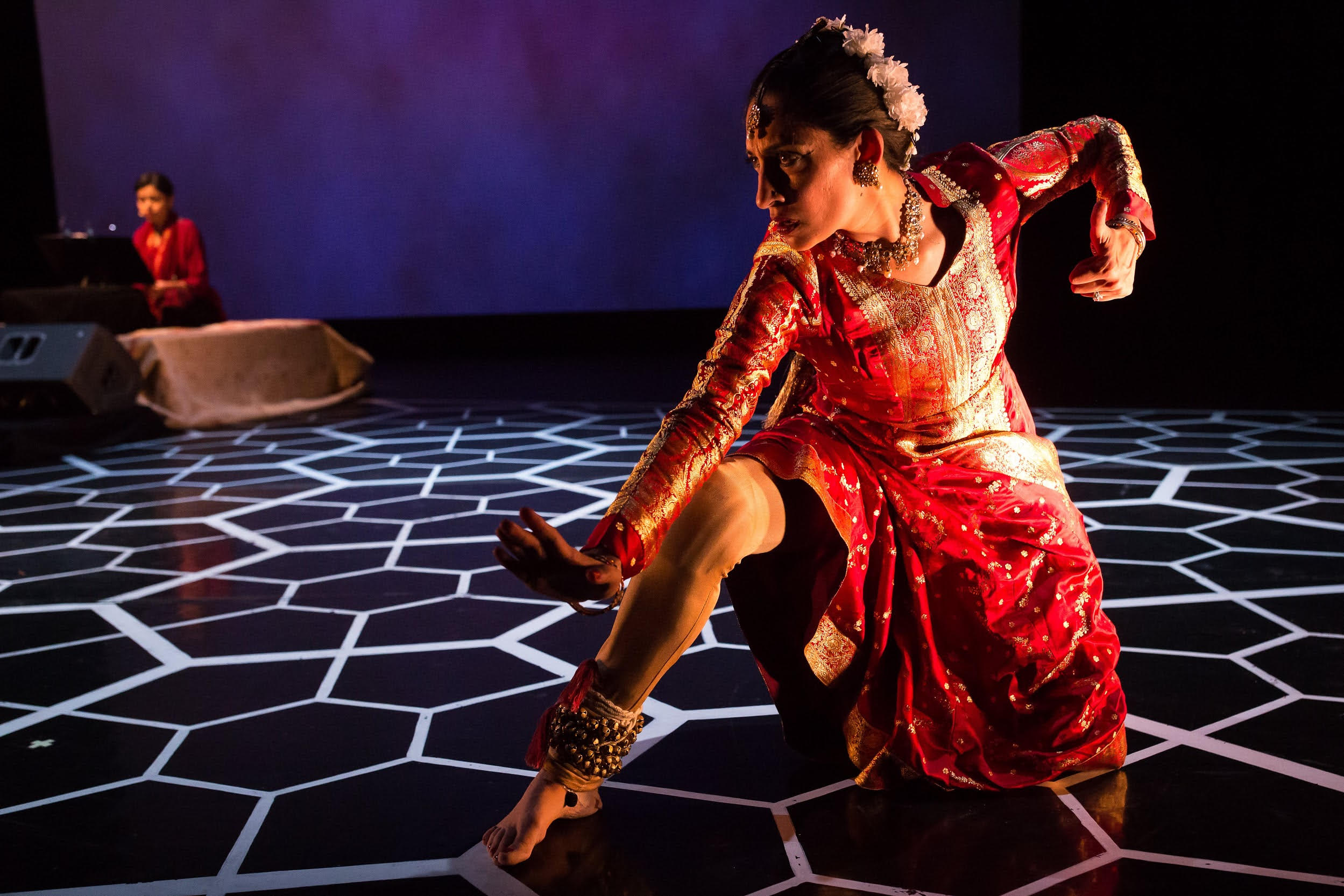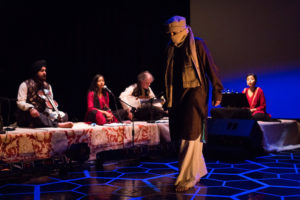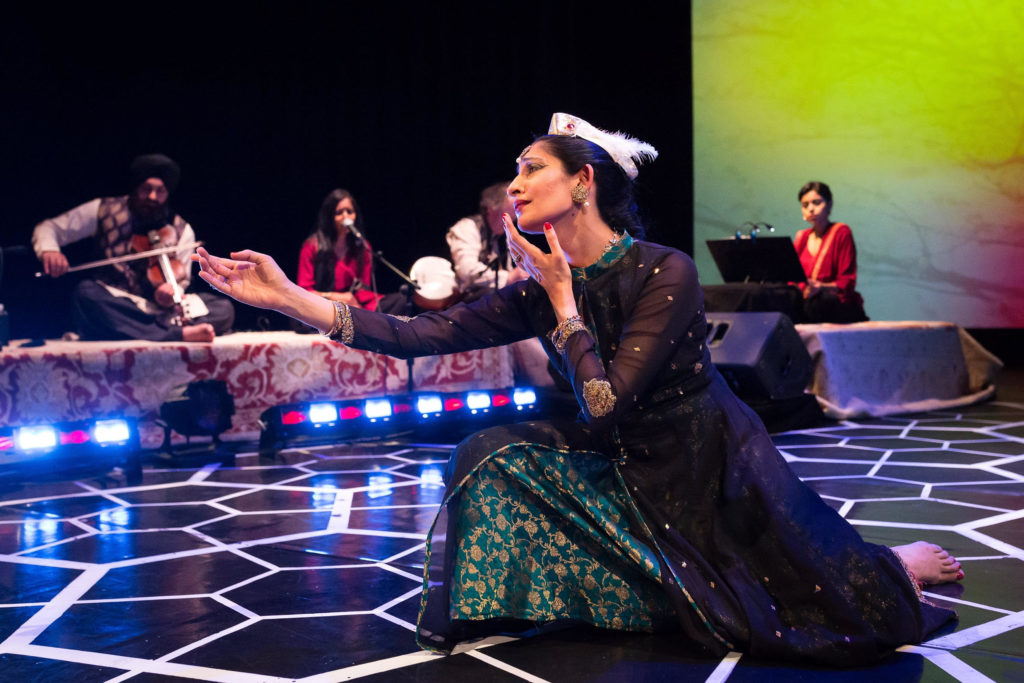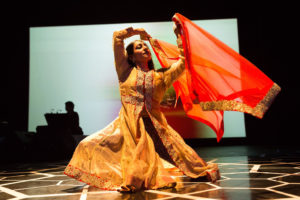
Photos by Lynn Lane
Women of influence from around the world have made significant achievements over the centuries; yet, the stories of their triumphs are often overlooked. Fortunately, proponents of some lesser told historic events dedicate themselves to bringing these stories to light through their art. In honor of International Women’s Day this March Kathak artist Farah Yasmeen Shaikh, founder of Noorani Dance, will present The Forgotten Empress, the story of seventeenth century Empress Noor Jahan, the most influential Indian woman of her time. The forthcoming production conceived, choreographed, and danced by Shaikh, will be performed on two Bay Area stages in late February and early March with exuberant theatrics, live music, and multimedia. The Forgotten Empress first premiered in Lahore, Pakistan in 2017, in the very city where Empress Noor Jahan is laid to rest.
 The Forgotten Empress is the fascinating true story of Empress Jahan, a rare, brilliant, and gifted empress of many talents. Empress Jahan attained unprecedented equal power and authority to her emperor husband for a time, essentially becoming the de facto ruler of the Mughal Empire while her husband presumably dealt with alcoholism and opium addiction.
The Forgotten Empress is the fascinating true story of Empress Jahan, a rare, brilliant, and gifted empress of many talents. Empress Jahan attained unprecedented equal power and authority to her emperor husband for a time, essentially becoming the de facto ruler of the Mughal Empire while her husband presumably dealt with alcoholism and opium addiction.
Discerningly well versed in the complex gestural language of Kathak, after performing with Chitresh Das Dance Company for many years, Shaikh found her own artistic vision through stories of history, politics, and social relevance. She says, “I believe I’m drawn to these topics because they move me personally due to my family history and being a Muslim woman dancing this form, and especially now that I work so frequently in Pakistan. However, I also feel a sense of responsibility in using my privilege as an American to shed light on these topics through the medium that has been gifted to me. I’m also a proponent of learning from our past to inform our present and change our future – for the better.”

The Forgotten Empress, as told in playwright Matthew Spangler’s stage adaptation, is a departure from what is considered traditional Kathak storytelling. The origin of Kathak dance dates back to the sixteenth century in Hindu scriptures, when epic tales and spiritual stories of devotion were performed in Hindu temples. Over time, Kathak evolved into a form of entertainment before the royal court.
By tradition, a Kathak artist is a soloist virtuoso with the supreme ability to portray all character roles (both male and female), enact every character emotion using facial expressions, dance, and elements of mime, demonstrating a capacity to transport audiences.
 Kathak, derived from the Sanskrit word “Katha” – meaning “story,” is native to Northern India and asserts three main schools of Kathak – based on the regions from which they originate; Lucknow, Jaipur, and Banaras. Before long, stories began to integrate elements of both Hindu and Muslim culture.
Kathak, derived from the Sanskrit word “Katha” – meaning “story,” is native to Northern India and asserts three main schools of Kathak – based on the regions from which they originate; Lucknow, Jaipur, and Banaras. Before long, stories began to integrate elements of both Hindu and Muslim culture.
Shaikh’s introduction to dance began at age five with the study of ballet and jazz, along with baton twirling, offered at the same dance school; all three of which she continued her training in until she was eighteen. In Shaikh’s experience, she found baton twirling to be an invaluable medium for developing technique. And while training in ballet and jazz, Shaikh developed a solid foundation in movement and choreography, team building and competition, body awareness and teaching, and an avid appreciation for her mentors.
In 1996, midway through her freshman year at San Francisco State University (SFSU), Shaikh discovered Kathak dance through the Classical Indian dance master, the late Pandit Chitresh Das, who happened to be teaching the first university accredited Kathak course in the country. Shaikh’s decision to pursue a dance form she knew little about was a choice based on her desire to feel closer to her culture and help overcome certain cultural insecurities. To her advantage, Shaikh’s previous dance training and familiarity with the music of India at home helped dispel any lingering doubt about this newfound pursuit. One day a week the lesson included a 50-minute lecture, followed by two separate days of 50-minute dance classes.
While Shaikh continued her educational pursuit toward a degree in Women’s Studies from SFSU, she embraced the lifelong commitment to learning the Kathak tradition through her instructor Das. Shaikh recalls, “I was so challenged by so many aspects of the form and completely taken by the teaching style of my GuruJi (also referred to as Pandit or Das). Pandit was faithful to its classical foundation – Kathak as a way of life, a service to society, and a path to self-knowledge.”
Shaikh’s teacher Das was a child prodigy schooled in two of the Kathak traditions, Lucknow and Jaipur, both of which he taught his student disciples. His performance career in India led to international acclaim, eventually bringing him to the United States in 1970 through a Whitney Fellowship with a commission to teach Kathak at the University of Maryland; thus, serving as an integral part in bringing Kathak to America. By 1980, Das established his own school, the Chhandam School of Kathak and the Chitresh Das Dance Company.
As a student, Shaikh says, “My GuruJi gave limitlessly to his students, and for the most part that was the case for me most of the time. The way GuruJi trained my peers and I was to maintain a standard and style that he developed, but he also kindled our individual styles and strengths simultaneously.”
She continues, “GuruJi had this uncanny ability to be what he referred to as a ‘modern Guru in training.’ He was a traditionalist in so many ways – old school, hard core, often steeped in tough love. His lessons existed on and off the dance floor. But then he could be this super laid back person to hang out with, laugh with. He was able to identify the potential in each of his students, and this is something I try to do with my students as well. He knew how to push and protect just enough and held up the proverbial mirror for us (his students) to recognize and see our own strengths and weaknesses – finding parallels to how we approach our dance to that of how we live our lives. He kindled a deep sense of self awareness in me and that, in addition to training my students with integrity and a compassionate sense of nurturing, is something I try to utilize in my own teaching.”
Shaikh distinctly recalls the time when Das revealed her readiness to perform her first Kathak solo. She shares, “I had been training with my GuruJi for over 10 years at this point, and I had been a member of his company for just shy of that. I had done some smaller solo performances that had also lent to my experience and preparedness. Ultimately what deemed me ready was the indication from my GuruJi through not only his blessing and/or permission, but that he felt I was ready to take on the process and the commitment. And that he felt I was able to engage with the musicians without him always being present to direct them or me.”
To perform as a Kathak soloist, four elements must be mastered; all of which are equally important: ‘Tayaari’ (technical readiness), ‘Laykaari’ (rhythmic virtuosity), ‘Khoobsurti’ (beauty and grace), and ‘Nazaakat’ (delicacy/refinement).
In the years that followed, a shift occurred in Shaikh and her GuruJi’s relationship. Shaikh explains, “In 2014, I decided to attempt to navigate this path on my own. I needed to take risks, learn from them, not feel controlled by others, and keep moving forward. GuruJi and I did not part on good terms, and generally speaking, stepping away from the Guru is most often frowned upon in traditions such as Kathak, but carrying the dance forward on my own felt like the best way to continue to honor his teachings, and enable me to discover my own artistic voice.”
As an independent artist, Shaikh has adapted many poems into Kathak dance pieces. In 2015, Shaikh premiered Indu Sundaresan’s The Twentieth Wife at Z Space in San Francisco, her first full length production in which she choreographed, performed, and helped adapt for the stage; phase one of Shaikh’s tribute works dedicated to the Empress Noor Jahan. That same year, Das passed away suddenly at the age of 70. Though there was no reconciliation between the two Shaikh feels a deep commitment to share his gifts.
Shaikh began training the next generation of Kathak artists in 2015, when she established Noorani Dance in Menlo Park. A traditional Kathak dance school for students age five and up, training includes the foundational aspects of movement technique, the theoretical aspects of the music, as well as the history and philosophy.
Currently, Shaikh is working with a children’s book author in Pakistan to adapt her story for a new dance drama. Further expanding her production repertoire, Shaikh says, “My next production for approximately 50 of my students is based on the time during the Mughal period known as the Golden Age when Emperor Akbar was ruler. He was known for creating an environment in which the arts flourished and people of various faiths coexisted and embraced one another’s traditions and cultures. The show titled Sunehra Noor – A Golden Light also has a legend that emphasizes the arts as a natural force, has the power to set fire, but also bring rain to put out the fire.”
Shaikh has busied herself with another project: “I am working on the next iteration of The Partition Project in which dance will be at the forefront of examining stories and messages related to the 1947 India-Pakistan Partition (independence from the British Empire), bringing us to the present day, where the tension between the two countries is still ever present,” says Shaikh.
And starting February 11, 2020, Shaikh will host a new podcast, The Heartistry, on DASH Radio’s Rukus Avenue Radio; available on various podcast platforms. Invited guests will include professionals from a variety of industries around the globe, with a deep commitment to their work.
Believe it or not, in between teaching, choreographing, networking, hosting a podcast, developing stories for the stage, and preparing for the upcoming production of The Forgotten Empress, remarkably Shaikh made time to host a local TED Talk in recent weeks. Really. By no stretch of the imagination, Shaikh’s ambition has no limits. Evidently when you’re a woman of influence, or at least this woman of influence, ideas never cease.
This article appeared in the March 2020 issue of In Dance.


